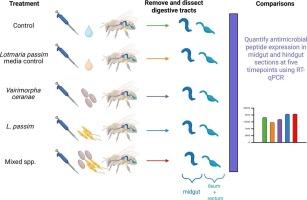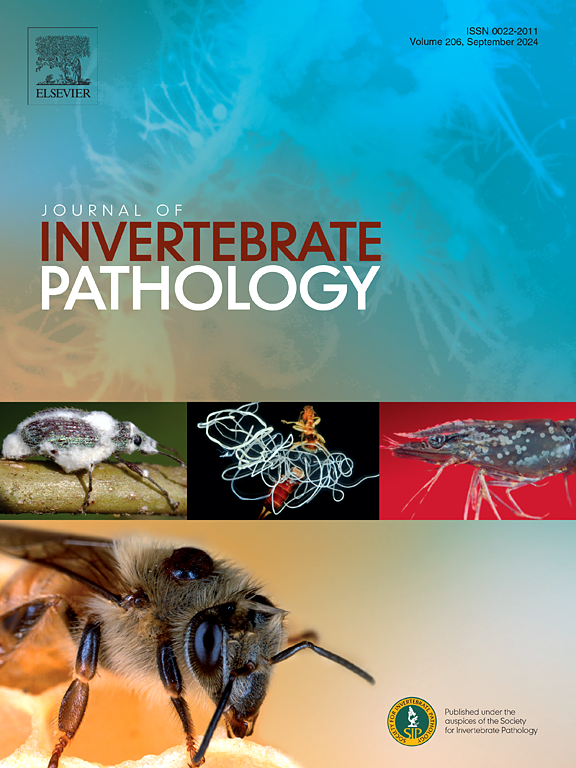蜂王和枇杷膏对蜜蜂消化道抗菌肽表达的影响
IF 2.4
3区 生物学
Q1 ZOOLOGY
引用次数: 0
摘要
蜜蜂变形虫(Nosema) ceranae和Lotmaria pasm是西方蜜蜂(Apis mellifera L.)两种常见的消化道寄生虫。尽管这些寄生虫与蜂群损失有关,但人们对它们如何影响蜜蜂的体液防御反应知之甚少,特别是在发现寄生虫的消化道水平上。利用当地获得的寄生虫分离物,通过在感染后5个时间点量化三种抗菌肽(apidaecin、防御素-1、膜膜蜂素)的表达,在消化道水平上评估单一和混合ceranae和L. passim感染对蜜蜂体液防御反应的影响。在这五个时间点还监测了消化道组织中的寄生虫密度,以确定寄生虫,特别是寄生乳杆菌,是否有不同的宿主组织偏好。一般来说,我们发现蜜蜂在消化道内对单一或混合的蜜蜂弧菌和被动乳杆菌感染都没有引起明显的体液防御反应。与中肠组织相比,五个时间点后肠组织中的弓形虫密度均有所增加,这表明后肠偏爱弓形虫。有趣的是,对于接受混合感染的蜜蜂,后肠组织中的被动乳杆菌和ceranae的密度都升高了,这表明两种寄生虫之间可能发生了相互作用。本文章由计算机程序翻译,如有差异,请以英文原文为准。

Effects of Vairimorpha (Nosema) ceranae and Lotmaria passim on antimicrobial peptide expression in the digestive tract of honey bees (Apis mellifera L.)
Vairimorpha (Nosema) ceranae and Lotmaria passim are two commonly encountered digestive tract parasites of the Western honey bee (Apis mellifera L.). Although these parasites are associated with colony losses, little is known regarding how they affect the bee humoral defense response, particularly at the level of the digestive tract where the parasites are found. Using locally-obtained parasite isolates, the effects of both single and mixed V. ceranae and L. passim infections on the bee humoral defense response were evaluated at the digestive tract level by quantifying the expression of three antimicrobial peptides (apidaecin, defensin-1, hymenoptaecin) at five timepoints post-infection. Parasite density was also monitored in digestive tract tissues at these five timepoints to determine if the parasites, particularly L. passim, have distinct host tissue preferences. In general, it was found that bees do not elicit distinct humoral defense responses within the digestive tract in response to infection with either single or mixed V. ceranae and L. passim infections. Increased L. passim density in hindgut tissues compared to midgut tissues at each of the five timepoints suggests a hindgut preference for the parasite. Interestingly, for bees that received mixed infections, both L. passim and V. ceranae densities were elevated in hindgut tissues, suggesting that there could be an interaction occurring between the two parasites.
求助全文
通过发布文献求助,成功后即可免费获取论文全文。
去求助
来源期刊
CiteScore
6.10
自引率
5.90%
发文量
94
审稿时长
1 months
期刊介绍:
The Journal of Invertebrate Pathology presents original research articles and notes on the induction and pathogenesis of diseases of invertebrates, including the suppression of diseases in beneficial species, and the use of diseases in controlling undesirable species. In addition, the journal publishes the results of physiological, morphological, genetic, immunological and ecological studies as related to the etiologic agents of diseases of invertebrates.
The Journal of Invertebrate Pathology is the adopted journal of the Society for Invertebrate Pathology, and is available to SIP members at a special reduced price.

 求助内容:
求助内容: 应助结果提醒方式:
应助结果提醒方式:


